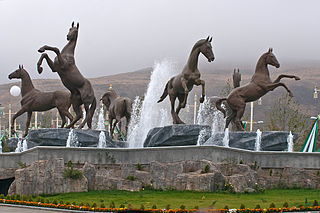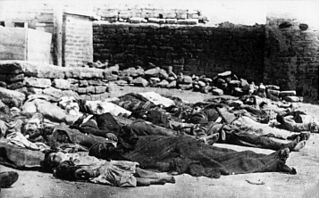
Stepan Georgevich Shaumian was an Armenian Bolshevik revolutionary and politician active throughout the Caucasus. His role as a leader of the Russian Revolution in the Caucasus earned him the nickname of the "Caucasian Lenin", a reference to Russian revolutionary leader Vladimir Lenin.

The Allied intervention in the Russian Civil War consisted of a series of multi-national military expeditions that began in 1918. The initial impetus behind the interventions was to secure munitions and supply depots from falling into the German Empire's hands, particularly after the Bolsheviks signed the Treaty of Brest-Litovsk, and to rescue the Allied forces that had become trapped within Russia after the 1917 October Revolution. After the Armistice of 11 November 1918, the Allied plan changed to helping the White forces in the Russian Civil War. After the Whites collapsed, the Allies withdrew their forces from Russia by 1925.

The Transcaspian Oblast, or simply Transcaspia, was an oblast of the Russian Empire and early Soviet Russia to the east of the Caspian Sea during the second half of the 19th century until 1924.

The Trans-Caspian Railway is a railway that follows the path of the Silk Road through much of western Central Asia. It was built by the Russian Empire during its expansion into Central Asia in the 19th century. The railway was started in 1879, following the Russian victory over Khokand. Originally it served a military purpose of facilitating the Imperial Russian Army in actions against the local resistance to their rule. However, when Lord Curzon visited the railway, he remarked that he considered its significance went beyond local military control and threatened British interests in Asia.

Gyzylarbat is a city subordinate to a district in Turkmenistan, located north-west of the capital, Ashgabat on the M37 highway to the Caspian Sea. The population of Gyzylarbat is 50,000 people, mainly Turkmen. The main language spoken in the region is Turkmen. It is near the northwest end of the line of oases on the north slope of the Kopet Dag that extends southeast to Ashgabat.

The March Days or March Events was a period of inter-ethnic strife and clashes which took place between 30 March – 2 April 1918 in the city of Baku and adjacent areas of the Baku Governorate of the Transcaucasian Commissariat.

The 26 Baku Commissars were Bolshevik and Left Socialist Revolutionary (SR) members of the Baku Commune. The commune was established in the city of Baku, which was then the capital of the briefly independent Azerbaijan Democratic Republic, and is now the capital of the Republic of Azerbaijan. The commune, led by Stepan Shahumyan, existed until 26 July 1918 when the Bolsheviks were forced out of power by a coalition of Dashnaks, Right SRs and Mensheviks.
Reginald Teague-Jones MBE was a British political and intelligence officer. He was active in the Caucasus and Central Asia during the Russian Civil War. For the last 66 years of his life he was known as Ronald Sinclair. Under that assumed name, he authored two published accounts of his travels and adventures in Asia and the Middle East.

Meyer Velkovich Basin was a member of the Military Revolutionary Committee of the Caucasian Army.

The Tashkent Soviet was a public organisation set up in Tashkent during the Russian Revolution. It was established on 2 March 1917 at an inaugural meeting that consisted of thirty five workers from the Central Asian Railway. It was headed by a technician named I. I. Bel'kov. The following day, there was a meeting in the local Duma which set up an Executive Committee of Public Organisations to manage the "sociopolitical and economic life of the city".

Fyodor Adrianovich Funtikov was Chairman of Provisional Executive Committee of the Transcaspian Region Soviet during the period July 1918 – Jan 1919. He was a Socialist Revolutionary railway worker, who in his role as head of the Transcaspian Government was held responsible for the execution of the 26 Baku Commissars.

The Council of People's Commissars of the Russian Soviet Federative Socialist Republic was the government of Soviet Russia between 1917 and 1946. It was established by the Second All-Russian Congress of Soviets of Workers', Soldiers', and Peasants' Deputies on November 9, 1917 "as an interim workers' and peasants' government" under the name of the Council of People's Commissars, which was used before the adoption of the Constitution of the Russian Socialist Federative Soviet Republic of 1918.

The Malleson mission or British intervention in Transcaspia was a military action by a small autonomous force of British Indian troops, led by General Wilfrid Malleson, operating against Bolshevik forces over large distances in Transcaspia between August 1918 and April 1919, in the context of the Allied intervention in the Russian Civil War.

Colonel Charles Howard "Dick" Ellis (1895–1975) was an Australian-born British intelligence officer credited with writing the blueprint for United States wartime intelligence agencies Coordinator of Information and Office of Strategic Services, what would become the CIA. For his contribution to the United States in World War II, he received the Legion of Merit from President Harry S. Truman.

Gaygysyz Atabayev was a Turkmen Soviet politician. He was born in Transcaspian Oblast. He was the first prime minister of the Turkmen Soviet Socialist Republic.
Pável Gerásimovich Poltorátskiy was a Bolshevik revolutionary. He served as People's Commissar for Labor in the early Turkmen Soviet Socialist Republic and as editor of the daily newspaper Sovetskiy Turkmenistan.

The Turkestan Army was a White army during the Russian Civil War, which operated from January 1919 to February 1920, in the Transcaspian Oblast area.
The Kolesov's Campaign was an unsuccessful attempt to seize power in the Emirate of Bukhara by the Russian Bolsheviks and Young Bukharans during the Russian Civil War.
The Turkestan Military Organization was an anti–Bolshevik military underground organization created in February 1918 in the Turkestan Territory of the Russian Empire, with its center in the city of Tashkent, a group of former officers of the Tsarist Army and a number of representatives of the Russian intelligentsia and officials of the former administration of the Territory with the aim of overthrowing Soviet Power in the province.

The Tashkent Rebellion was a 1917 conflict between revolutionary forces and loyalists of the Russian Provisional Government, which occurred in Tashkent, in what is now Uzbekistan. The events leading to the conflict began on 14 March 1917 [O.S. 1 March 1917], when local leader Aleksey Kuropatkin received word of the February Revolution. Rule shifted to various political parties in the city, and the Tashkent Soviet was created. As time progressed, Imperial officials were replaced, the soviet gained more power, and a regional soviet was created in addition to the existing council. The Russian Provisional Government began attempting to regain control in April, but the soviets tightly restricted its efforts. Many locals rallied in support of soviet power, and in September and October, conflict began between the parties, ending on 10 October [O.S. September 27].

















